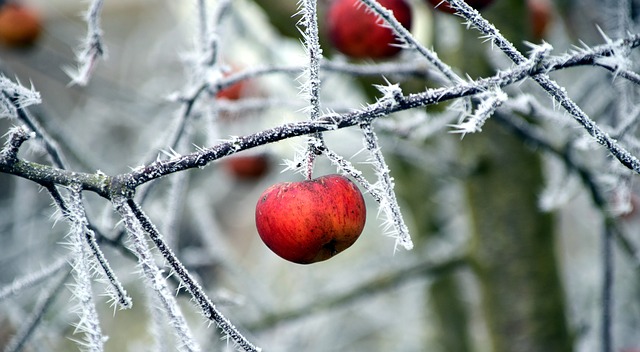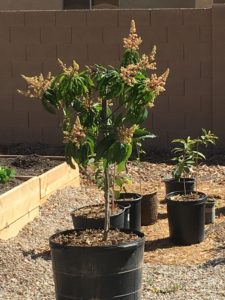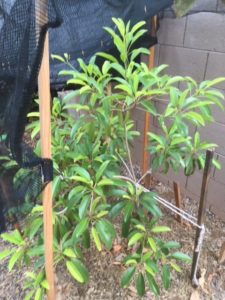How to Protect Tropical Fruit Trees from Cold

Living in the Arizona desert where temps are routinely over 100 degrees Fahrenheit, you’d never think that cold would be an issue with growing fruit trees. Surprisingly, we can occasionally get below freezing temps.
One unique thing about the desert is since we have relatively low humidity and cloud cover, temps can fluctuate 40 degrees from daytime to night time. Depending on the type of fruit trees you are growing, the few nights of sub-freezing temps that we get can wreck more havoc, then the months of extreme heat.
Growing Zone
Here in Phoenix, Arizona we are mostly considered to be located in growing zone 9B. If you’re unsure of what zone you’re in check out this USDA Plant Hardiness Zone Map.
Once you identify your growing zone than it will help you to understand what you are realistically able to grow outdoors. Our zone is marginal for tropical and subtropical fruit trees.
Many subtropical fruit trees can handle some temps below freezing for short periods of time, but long durations can kill the tree.
Cold snaps in my area tend to last in the late night and early morning hours just before the sunrise. If you’re in a zone less than zone 9, it’s going to really be tough to keep most tropical and many subtropical trees alive if planted outdoors.
Alternatives

Greenhouse
One way to grow tropical fruit trees in a colder climate is to have a greenhouse. If you can keep the trees warm enough and with enough light throughout the winter then you can have success growing most tropicals.
It can be costly to build and maintain a greenhouse, but if money isn’t an issue, then go for it. Also, you’ll need adequate space.
Containers
Another effective way to grow tropicals if you get some colder winters is in a container. This is a method that I utilize for some of my colder sensitive tropical fruit trees.
I write a post here on growing fruit trees in containers, which goes in-depth on container growing. Just keep in mind that containers can get extremely heavy to move around depending on the size and container type.
Since our cold snaps are only usually a handful of nights, I can just move them into the house or garage for a few nights as needed. If you’re planning on moving them in for the winter then you’ll need adequate light, as well as space.

Stone Fruits
I’m growing a mix of tropical and stone fruit trees in my urban backyard garden. It’s somewhat of a catch-22 because the stone fruit trees need some cold, whereas the tropical’ s want to be as far away from cold as possible.
If it’s just too cold in your climate and you’re unable to do some of the other alternatives, it may be best to just stick with growing stone fruit trees. Things like peaches, plums, apples, nectarines, jujube, pomegranates, figs, cherries, or pears could be considered.
Protecting Fruit Trees Outdoors During Cold Snaps
If you’re in a marginal climate like zone 9 and are growing some of your subtropical and tropical fruit trees outdoors, you’ll need to be prepared to frost protect.
If I see weather forecasts that are predicting anything below 35 degrees Fahrenheit, I’ll start frost protecting.
Here are a few ideas that can help:
Plant Near Things
Planting near concrete block walls or houses can help your tree stay warmer. The concrete will absorb warmth through the day and radiate the heat at night.
In marginal climates, tropical fruit trees don’t get that large because the climate conditions restrict the growth. Large 55-gallon water barrels can have the same effect of warming during the day and putting off some heat at night.
Planting under the canopy of trees or eaves can help act as a shelter from frost. Cold air tends to sink, so watch out for those open low spots in your yard.
Water
Many local citrus orchards in our area will flood the orchards on cold nights because the water will put off a bit of warmth. It can be a good idea to water heavily the evening before a cold snap. Some tropicals like Papayas or Atemoya’s rot easily in cold wet soils, so know your trees before doing this.
Cover your Fruit Trees
Using things like blankets or plastic can help keep your fruit trees a few degrees warmer which can be life or death to some fruit trees. Keep the blankets or plastic off the tree by building a structure around the tree.
You can build a frame for your tree for a relatively low cost. Just get 8 foot long wooden stakes and hammer four around the tree area creating a box. Wrap with 6mil plastic and place a sheet on top. You can easily open this up during the day when temps warm up to allow air flow.
Whatever you use, it should run all the way to the ground. Warm air radiates from the ground and you want to trap that warmth in.
Add a Heat Source
When it gets into the 20’s Fahrenheit, you’re going to need something more. I use heat lamps or even occasionally small heaters. BE CAREFUL of anything that could be potentially a fire hazard.
Out of the Norm Ideas
The Tree T-Pee is a product that fits around the base of your fruit trees. It looks similar to a large Christmas tree stand. The makers of Tree T-Pee claim that it can aid in frost protection, by keeping the base of the tree warmer with the humidity inside the T-Pee.
Top Tropicals sells a product called Sunshine Booster that is a liquid-based plant hormone that is said to improve cold tolerance. I’ve yet to try this product but have been curious about the effectiveness.
Research has shown that Liquid Seaweed acts as anti-freeze to plant cells. I generally use this more frequently in the winter as both folier and in ground-feeding applications for more tropical fruit trees.
Here are the products I use and recommend.
Give it a Try

One of the things I love about gardening is just experimenting and trying new things. If you are in a marginal climate for growing something, try to push the boundaries.
Your microclimate is unique and different from your neighbors, which may be able to provide an environment better suited for what you want to grow.
I’ve learned a few things from trial and error when it comes to cold tolerance. Some trees that I thought could handle a bit more cold haven’t and others that I thought needed more protection didn’t.
I have dipped into the upper 20’s in my yard on a few occasions. I had a young Barbados Cherry succumb to cold without any cold protection. Some of my guava trees get crispy leaves during cold snaps but always bounce back without protection.
I’ve been able to grow Atemoya, Mango Trees, Guava, Papaya, Sapodilla in the ground outdoors in temps into the 20’s with some protection.
All in all, it’s exciting trying to push the limits of gardening and try different things. I would’ve never thought that some of the tropical fruit trees I’ve been growing for years would’ve been able to grow in the desert. With some care and effort, you can grow tropical trees outside of the tropics.
Please comment below on anything you’ve enjoyed from this post or what has worked for you for cold protecting tropical fruit trees.
